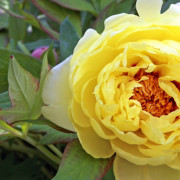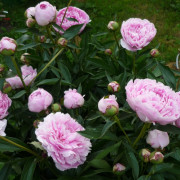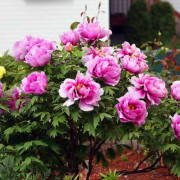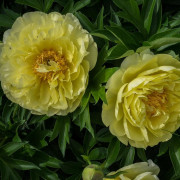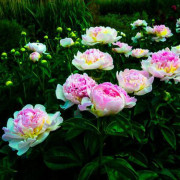Peony First Arrival
Content:
The early First Arrival peony illuminates flower gardens and florist shops. Motley, changeable and at the same time gentle - it is effective and eye-catching. Neat bushes adorn flower beds in spring and look vivid in bouquets. What are the features of the variety and how to care for such a flower should be considered in detail.
Peony First Arrival (Paeonia Itoh First Arrival) - history and features of the variety
Peony Fest Arrival, as the name of the flower sounds from the English, was bred in America in the 90s of the last century. This is a young and sought-after variety. His name means "first arrival" and is associated with the spring awakening, as variegated buds appear among the first among their fellows.
The prefix "Ito" in this group of varieties indicates that the hybrid refers to a mixture of treelike and milk-flowered breeds. This name was given to the flowers in honor of the pioneer of this type of breeding - the Japanese Toichi Ito, who worked during the Second World War.
Itoh First Arrival peonies are bushy perennials up to 80 cm in height with large, well-opened buds. The flower consists of several layers of smooth lilac-pink petals and a bright yellow core. Ripening, semi-double buds brighten, moving from light fuchsia to a delicate shade. In this case, dark purple spots remain at the bottom. The head reaches up to 25 cm in diameter. The leaves of the variety are juicy, smooth and dense, the stems are resistant.
Among the advantages of the variety are frost resistance, duration and accuracy of flowering, the power of the peduncle, early awakening, and the unusual corolla. Discoloration of the petals is considered a relative disadvantage. Every year the flower becomes more "curly" and multi-layered.
Peony First Arrival is widely used in landscape design and less often in interior decor and bouquets. Colorful compact bushes create excellent borders and borders, islands on walking lawns - both alone and in combination with other plants.
Growing a flower: planting in open ground
To get a First Errival hybrid Ito peony on your plot, the easiest way is to resort to the grafting method: it is simple, does not require a lot of experience from the gardener and after three years gives a striking result.
Planting scheme with root cuttings:
- They dig up a donor plant, disassemble the bush into root shoots, cut off all unnecessary branches and tops.
- On each seedling petiole there are 1-2 viable buds - a hole or a bump on the side, which will sprout after awakening.
- The lower end is cut diagonally, so it will be easier for the plant to root.
- The prepared seedling material is soaked for 2 hours in a weak solution of potassium permanganate for disinfection, then dried during the day by crushing it with crushed coal (otherwise the root can rot or get sick).
- Treated planting cuttings are immersed in the ground in a shaded place at least 15 cm apart, and added dropwise. After that, they regularly watered to root the seedlings, and weed the hole from the weeds.
- For the winter, the beds are covered with mulch to prevent the plants from sinking or freezing.
Root transplantation should be done in August - early September, while it is warm.During this time - before the onset of frost - the peony will have time to dissolve a high-quality root system and take root in order to winter reliably.
Preparing the beds: how to choose a place
The place chosen for the garden is important for the beautiful flowering of a healthy bush. Peonies bloom only on the sunny side, which is why you should not plant them near the parapets of buildings or in the shade of fruit trees - they, in addition to light, will take away nutrients from the soil from the flower.
A lush peony loves neutral soils with constant air access, so the soil within the radius of the flower needs to be loosened regularly. It is not worth pouring the plant, but in lowlands or rainy areas, provide high-quality drainage under the flower bed. In a good nutrient medium, such a perennial will bloom well for up to 30 years without transplanting.
Landing features (description):
- dig a hole under the peony bush at least 60 cm in diameter;
- expanded clay, natural stone or broken brick is laid on the bottom, filling the well by 10 cm;
- neutralize the soil with ash and dolomite flour (a handful is enough);
- fertilize the place with 2 tbsp. superphosphate;
- cover the bed with earth, digging in the planting material (the upper bud should be at ground level);
- the soil is well watered and compacted loosely.
Peony care First Arrival
In order for the peony of the Ito First Arrival variety to feel well in the garden allotted to it, proper care is necessary:
- mulching immediately after planting and in cold weather (sawdust, hay are suitable);
- regular loosening and weeding of the soil, elimination of large weeds and preservation of the flower circle;
- periodic feeding;
- regular watering at the root.
The soil under the plant must not be allowed to dry completely, each bush consumes up to 20 liters of water with a temperature of +20 ℃. After watering, the soil must be loosened to avoid crust formation.
Feeding schedule:
- in April, nitrogen and potassium are added for active growth;
- when the buds bloom - add complex fertilizer;
- by the end of the season at the end of August, phosphorus and potassium are added.
To prevent the appearance of rust, rot and aphids in April (early and late May), it is necessary to treat the soil with a fungicide.
Peony Blossom Fest Arrival
Paeonia First Arrival blooms early - already in May. As soon as the soil temperature reaches 5-8 ℃ above zero and the root system develops during the entire active flowering. Therefore, the flower needs feeding. In the heat, a period of rest begins. In the fall, the rhizomes from the suction ones pass into the storage ones, which allows the plant to overwinter calmly.
As soon as the first buds appear, the small lateral flowers are trimmed to allow the central heads to gather and grow. When they fade, the receptacle must be cut off, leaving part of the stem. It is better to remove fallen petals from the garden - the remains of nectar can become a breeding ground for pathogenic microorganisms.
If a mature plant (over 2-3 years old) does not bloom, you need to pay attention to the conditions for its development:
- if there is a lack of sunlight, it is worth moving the bush out of the shade;
- with increased acidity - treat the soil with ash;
- with lush greenery - to reduce the nitrogen content of the soil;
- old plant (more than 20-30 years old) - cut and rejuvenate;
- treat the root system from pests;
- pull the deeply planted plant closer to the surface.
Peonies after flowering
After the buds have faded, the plant is given time to go into dormancy. It is impossible to cut or transplant it during such a period, otherwise the bush may die.
Before wintering, it is enough to cut the tops up to 10 cm above the ground level and cover the earthen area with mulch.Erraival does not need greenhouse protection - this plant is surprisingly hardy and hardy.
Diseases, pests and ways to control them
The "pioneer" is weakly susceptible to disease. To prevent the plant from being struck by root rot and fungal infections, they provide high-quality drainage and carefully monitor watering to avoid stagnation of moisture in the soil. After trimming, the tops are burned. For prophylaxis, Bordeaux liquid and fungicide are periodically used.
Spider mites, ants and aphids are considered common pests for peonies. To protect the plant from insects in the most "natural" way, you can use garlic infusion, a more intense way is a soap solution. Professional florists also use systemic pesticides.
A simple and attractive peony Fest Arrival wide open to the sun is the best choice for decorating a path in the country, a city flower bed or your own flower garden. A rich gradient shade makes this variety versatile and unobtrusive. The plant is easy to care for, so it brings a lot of joy and pleasure to the gardener.













